
CF-100 Mk V

The CF-100 was the only Canadian designed and built aircraft to be produced in large numbers. In the early 1950s, Canada needed an interceptor able to patrol the vast areas of Canada's north and operate in all weather conditions. The two-seat fighter crewed by a pilot and navigator, was designed with two powerful engines and an advanced radar and fire control system housed in its nose that enabled it to fly in all-weather or night conditions. For its day, the CF-100 featured a short takeoff run and high climb rate, making it well suited to its role as an interceptor.
Design of the XC-100 to meet a RCAF specification for an all-weather fighter was initiated at Avro Canada in October 1946. The CF-100 Mark 1 prototype, "18101," emerged out of the factory, painted gloss black overall with white lightning bolts running down the fuselage and engines. The CF-100 prototype flew its maiden flight on 19 January 1950. The Mark 1 was powered by two Avon RA 3 turbojets with 6,500 lbf thrust each.
The second prototype, 18102, was also powered by Rolls-Royce Avons, although subsequent pre-production and production series aircraft used the Avro Orenda turbojet. Five pre-production Mk 2 test aircraft were produced (18103-18107) all fitted with the Orenda 2 jet engines; one was fitted with dual controls and designated a Mk 2T trainer. The first production version, designated Mk 3, incorporated the APG-33 radar and was armed with eight 50-caliber machine guns. The Mk 3CT and Mk 3DT were again dual control versions supplied to operational training units.
In September 1950, the RCAF ordered 124 examples of the Mk 3 version; the first of these entering Royal Canadian Air Force service in 1953. These were armed with eight 50-caliber machine guns. The definitive version rocket-armed Mk 4A was based on prototype Mk 4 (a modified Mk 3) first flying on 11 October 1952. The nose housed the much larger APG-40 radar with wingtip pods each containing up to 30 Mighty Mouse FFAR (folding fin aerial rockets) in addition to the guns. As the last 54 of an order for the Mk 3 were changed into the Mk 4 in 1954, total orders for the Mk.4 rose to 510. The Mk 4B version had more powerful Orenda 11s.
Five versions were produced, ending, from 1955 onwards, with the high-altitude Mk 5 that featured a 3 ft. 6 in. extended wingtip and enlarged tailplane, along with removal of the machine guns. The proposed Mk 6 was to have mounted Sparrow II missiles and been powered by after burning Orenda 11IR engines in an effort to provide an "interim" fighter prior to the introduction of the Avro CF-105 Arrow. A projected transonic swept-wing CF-103 was built in mock-up form in 1951, but was considered obsolescent even before the CF-100's demonstrated ability to exceed the speed of sound in a dive.
The Canuck was affectionately known in the RCAF as the "Clunk" because of the noise the front landing gear made as it retracted into its well after takeoff. Its less-attractive nickname was the "Lead Sled", a reference to its heavy controls and general lack of maneuverability, a nickname it shared with a number of other 1950s aircraft. Others included CF-Zero, the Zilch, the Beast, all references to an aircraft many pilots considered less glamorous than RCAF day fighters like the Canadair Sabre.
The aircraft operated under the US/Canadian North American Air Defense Command (NORAD) to protect North American airspace from Soviet intruders such as nuclear-armed bombers. Additionally, as part of the North Atlantic Treaty Organization (NATO), four Canuck squadrons were based in Europe with 1 Air Division from 1956–1962, and were for some time the only NATO fighters capable of operating in zero visibility and poor weather conditions.
The CF-100 served with nine RCAF squadrons at its peak in the mid-1950s. Four of these squadrons were deployed to Europe from late 1956–1962 under the NIMBLE BAT ferry program, replacing some NATO RCAF squadrons equipped with Canadair Sabre day fighters to provide all-weather defense against Soviet intruders. Canucks flying at home retained natural metal finish, but those flying overseas were given a British-style disruptive camouflage scheme - dark sea gray and green on top, light sea gray on the bottom.
In its lifetime, a total of 692 CF-100s of different variants were produced, of which 53 aircraft were delivered to the Belgian Air Force. Although originally designed for only 2,000 hours, it was found that the Canuck's airframe could serve for over 20,000 hours before retirement. Consequently, though it was replaced in its front line role by the CF-101 Voodoo, the Canuck served with 414 Squadron of the Canadian Forces at CFB North Bay, Ontario, until 1981, in reconnaissance, training and electronic warfare roles. After the CF-100 was retired, a number of aircraft still remain across Canada (and elsewhere) as static displays.
The Kit
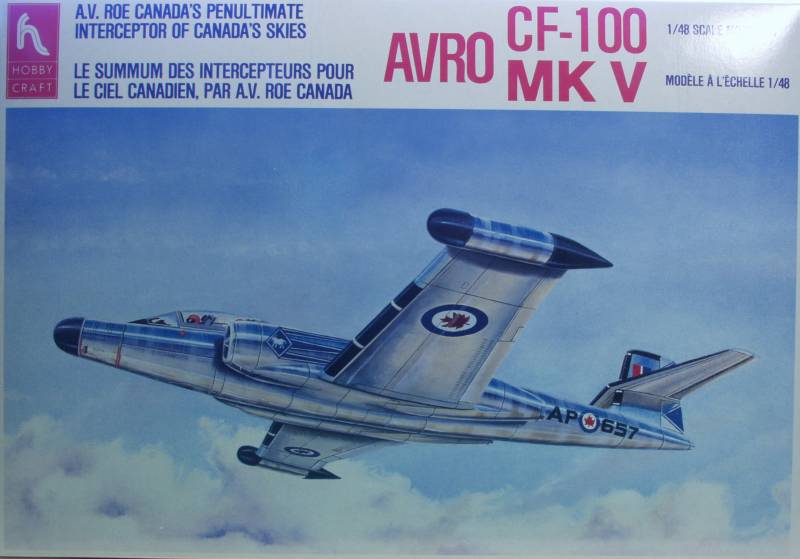
The Hobby Craft CF-100 comes in a two part top open box with reasonably attractive artwork on the top. Inside the box was one large bag containing all of the parts. The parts are molded in a light gray color and feature recessed panel lines. I now know where the panel line guy from Matchbox went when they closed as the panel lines look more like trenches. The parts are cleanly molded with little in the way of flash. Due to the rather large center section the fuselage from the nose to just aft of the engine outlets is molded top and bottom rather than side to side so there is no top or bottom seam and the side seam will be partially hidden by the wings. The balance of the fuselage is molded in the normal fashion and plugs into the assembled fuselage. This joint looks pretty good during test fitting but only time will tell. The kit includes both long range ferry tanks and rocket pods for the wings however the ferry tanks were designed to fit the shorter winged MK 4 variant and might requires some filling if you wish to use those. Since the only armament the MK 5 carried were the wingtip rocket pods they would probably be more appropriate anyway. See photos below.

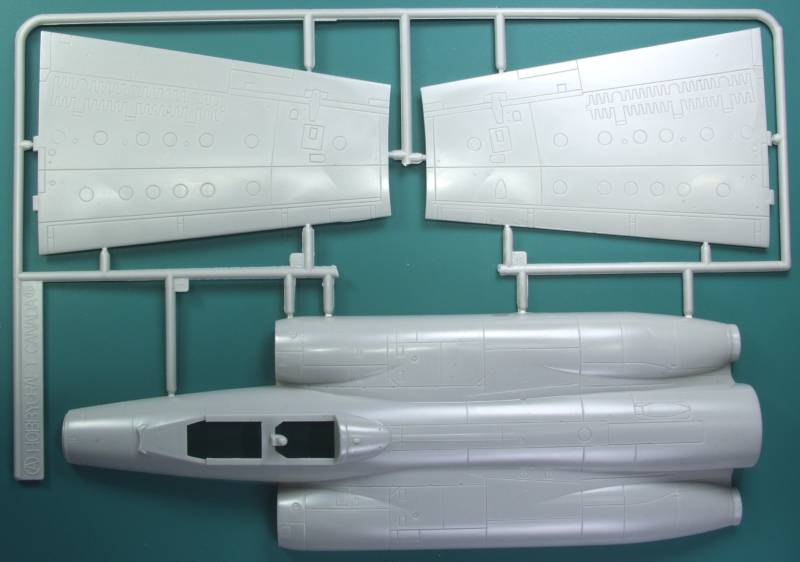
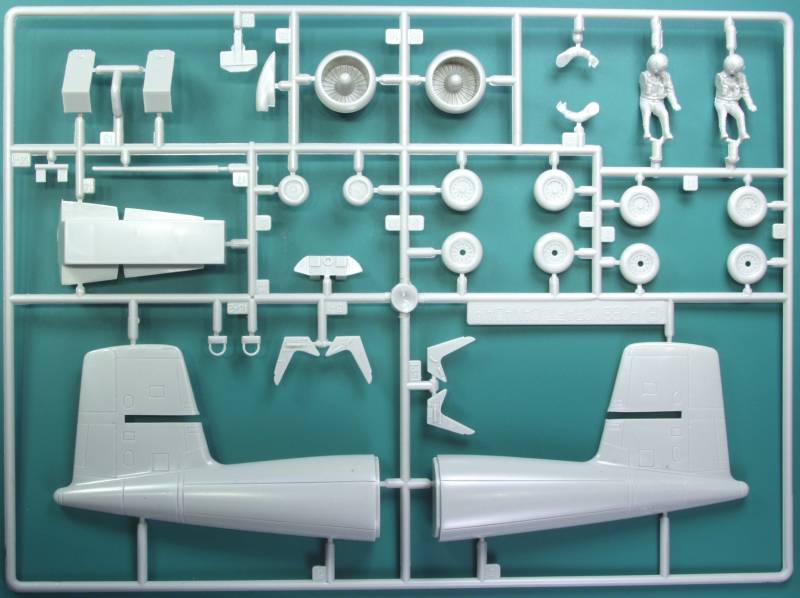
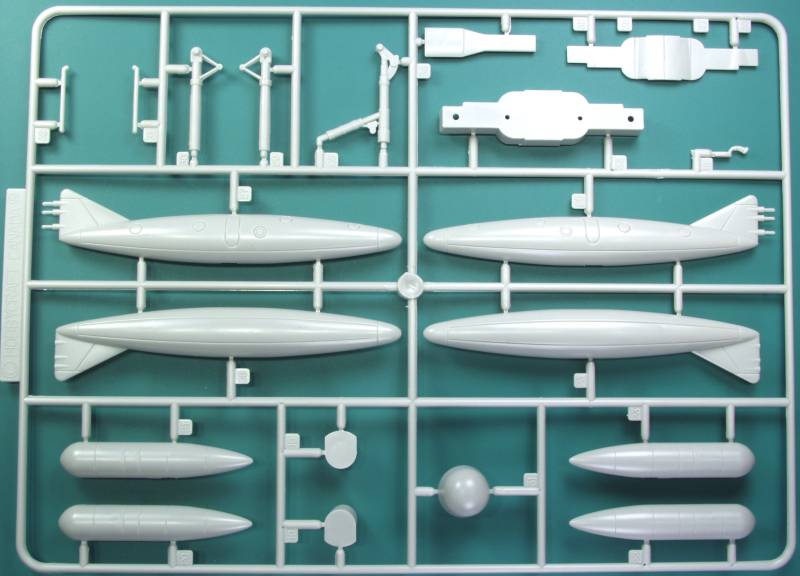
The clear parts are clear and free of defects if a tad on the thick side and consist of the main canopy in the closed position and a small windscreen which sat ahead of the radar operators position to protect that position when the canopy was jettisoned during bailout. See below.

The decals which provide markings for two aircraft are thin and don't look all that bad on the sheet except for the Belgian markings which are terribly out of register as are the Canadian fin flashes. There is a bit more clear material around some of them than I'd like to see. That combined with most of the unfavorable comments I have heard about Hobbycraft decals doesn't give me much confidence in them. See below.
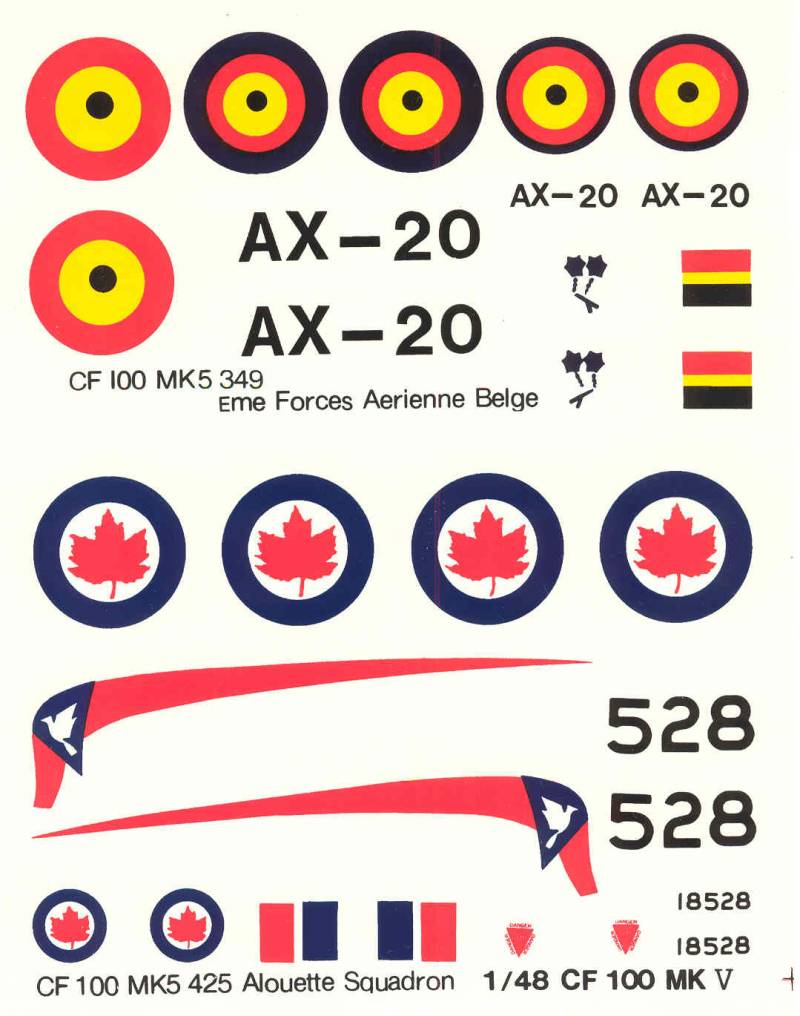
The instructions are printed on a long sheet folded to form eight 8 1/2" x 11" panels. The first panel has some brief history in two languages. There are four panels illustrating assembly and three with painting and marking instructions
After Market Goodies
I currently am not aware of any.
Conclusions
It's a shame that a Canadian company couldn't do a better job on what was a significant Canadian aircraft. While the kit isn't terrible it certainly is rather lack luster. While the fit for the most part was better than some short run kits it wasn't great either. The main top and bottom fuselage halves seemed to be slightly different in size leaving a step on one side if the other was lined up. The nose and engine intakes were larger than their mating parts requiring sanding to fit. The wing extensions left a large gap on the bottom side that need filling. The cockpit placement was fiddly and the pilot figures really didn't fit in the supplied seats. That combined with the over done surface detail didn't make for a pleasurable build. Unfortunately in this scale there is little other choice and with a bit of extra effort it can be built into a reasonable representation of this interesting Canadian designed and built aircraft. Recommended for modelers with a bit of experience under their belts !
Links to kit build or reviews
Another in box review can be found here.
References
CF 100 All Weather Fighter by Ron D. Page
Back to the Post War Jets page
The Build
As is the norm things started with the front office. While for the most part the structural details were correct the details on the instrument panels and side consoles were pretty much a result of the imagination of the mold maker as they bore little in common with photo's of the real thing. This would not be an issue, at least for me as you will see later it all disappears anyway. The color of the RCAF flight suits was a bit of a mystery to me and although I found some online references they did not include date information. A friend from Canada said his neighbor once flew CF-100's and he saw him in his flight suit on occasion and it was a light green color so I took a SWAG at it. The seats were poorly detailed and the crew didn't fit them well either as if they were taken from another kit.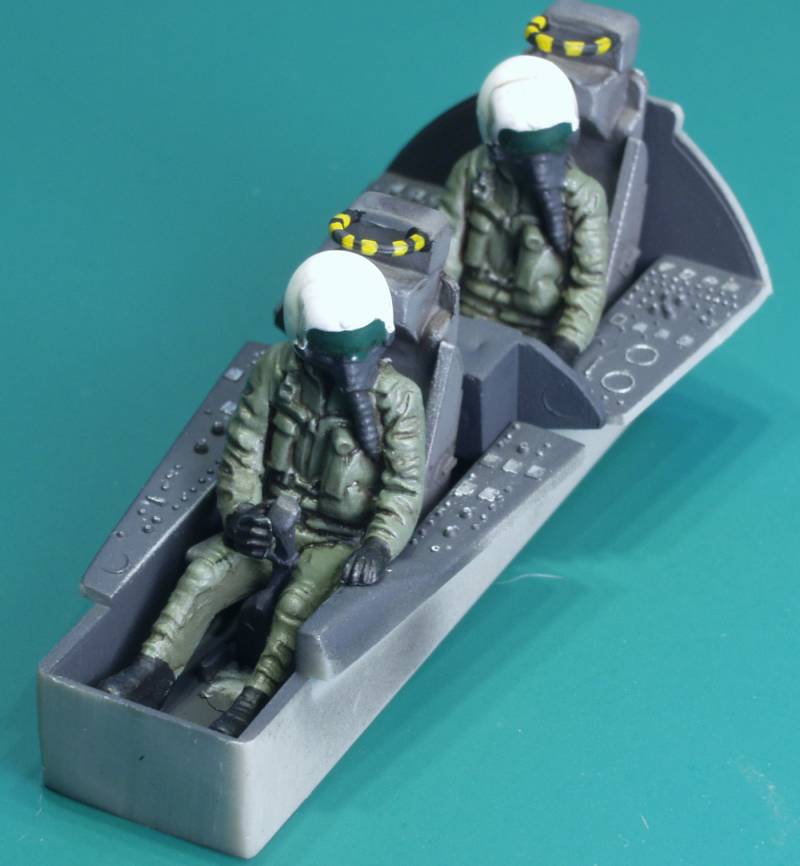
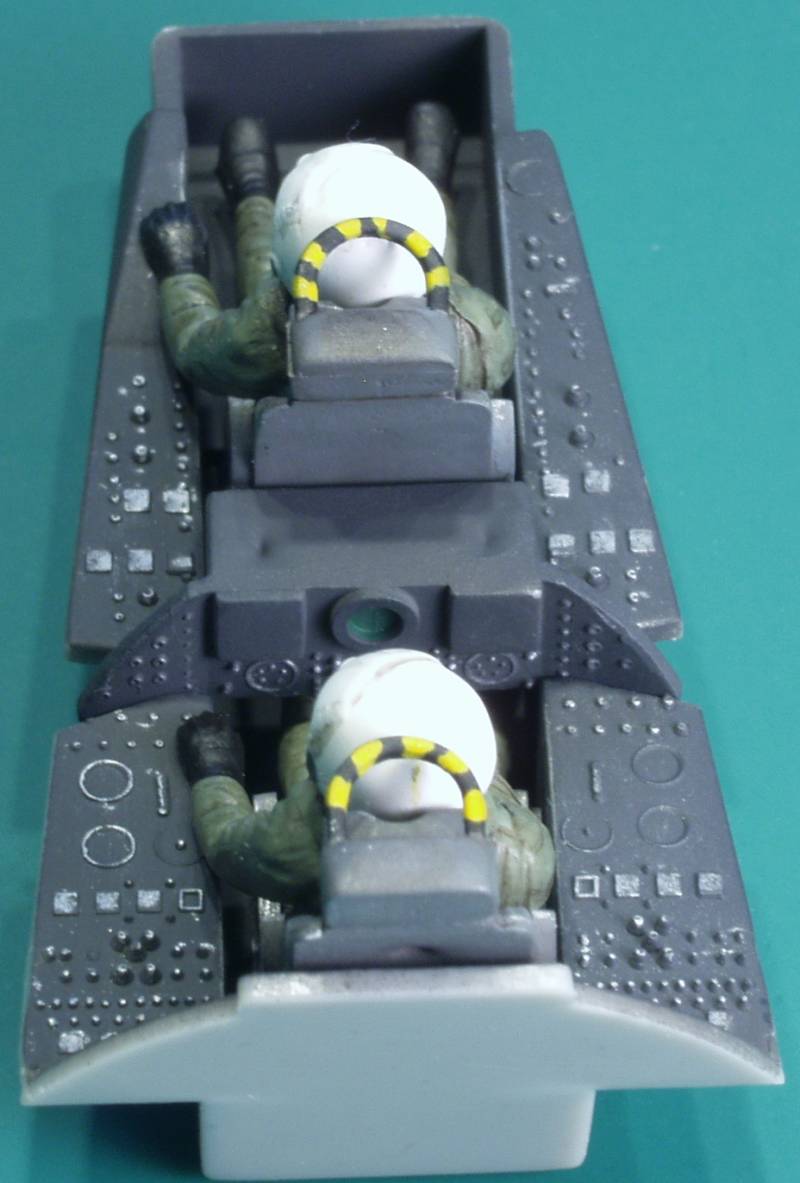
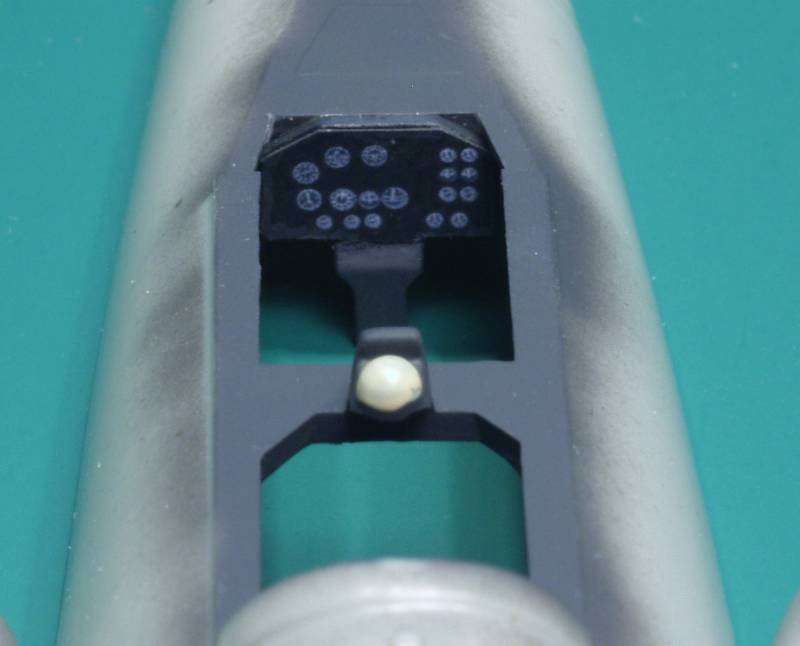
This shot shows why I wasn't too concerned about the appearance of the side panels, between the black of the pit and the way it fits, little can be seen of the interior.
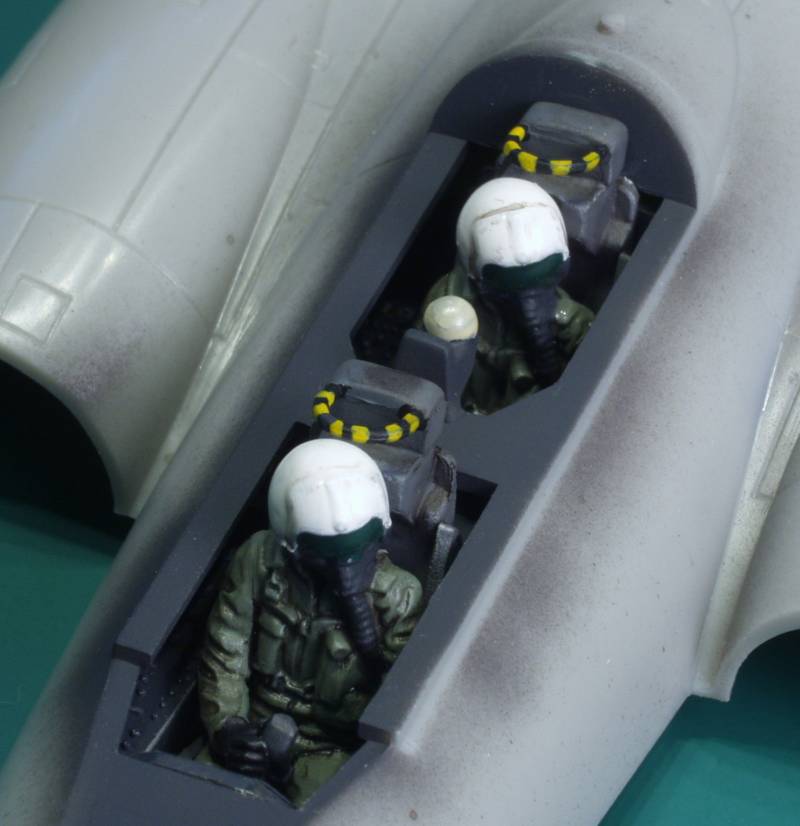
Back to the Post War Jets page